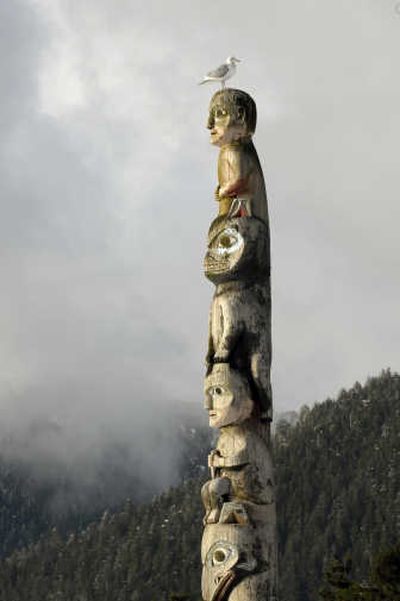Advocates want Sitka pole topper clothed

SITKA, Alaska – For nearly seven decades, a sad-eyed wooden lump of a man has been gazing out over Sitka Sound beset by the pelting rains and biting winds that whip in from the Pacific Ocean.
He’s the top man on a 40-foot totem pole, but his airy position may not be a sign of respect.
The figure of Alexander Baranov, an early 19th-century governor of Russian America, appears to be naked. Historians aren’t sure why, but some believe his lofty perch is an example of the “shame” poles that were carved to heap ridicule on their subjects.
Storyteller Bob Sam, a member of the Sitka Tribe of Alaska, would like to see Baranov get his clothes back. He has been lobbying to replace the aging pole with a new one that’s more closely tied to the original intent: commemoration of the peace treaty that Baranov helped broker in 1805 after a battle between the Russians and the Tlingit Indians.
“The original idea of the pole was to make peace so that the clan that was involved in the battle could move on with their lives,” said Sam.
“And it’s cold up there,” he added.
Sitka was the base of operations for fur traders with the Russian-American Company of which Baranov was chief manager. The period was marked by bloody skirmishes among the Russians, the Tlingits and rival traders from Britain’s Hudson Bay Company.
The pole was commissioned by the U.S. Forest Service 135 years after a pivotal battle that ushered in the peace talks. Its carvings include the dagger-bearing Tlingit warrior K’alyaan, a Russian bear and double-headed eagle and clan symbols like the frog and the raven.
Documents uncovered by Bob Medinger of the Sitka Historical Society indicate that it was made at the request of local Tlingit leaders of Sitka’s Kiksadi clan as part of a public works program to ease unemployment.
But instead of being carved in Sitka, the pole was carved in nearby Wrangell, historic rivals of the Sitka Indians and a former base of operations for the Hudson Bay Company. It stirred protests from the moment it was unveiled.
In a letter dated March 1942, native leader Andrew P. Hope pleaded with the BIA’s superintendent of Indian affairs to remove the pole and erect in its place one that was carved in Sitka instead.
Hope wrote that the pole did not represent the true story of the peace treaty, noting that Baranov was placed at the top of the pole “naket, dishonoring the great man who was in charge at the time of war and pease.”
“There were threats that this pole should not go up, and if it did there would be trouble, and it would be cut down,” said Medinger. “There were definitely some very hard feelings from the local leaders.”
Today, it’s hard to tell if Baranov is really in the buff; age and weather have peeled away the paint and softened contours. But researchers have examined the figure closely.
In a 2004 assessment of the pole’s condition, a National Park Service wood conservator used a crane to go eyeball to eyeball with the figure. He noted what looks like a loin cloth below the waist line but is actually a crudely carved wooden patch that appears to have been added once the pole arrived in Sitka.
“The patch is covering an area that could reveal the carving to be of a male figure,” Ron Sheetz wrote in a discreet reference to rumors that the original figure was anatomically correct.
Perhaps even more telling is the original design sketched by Tlingit carver George Benson of Sitka. It shows the bald round-headed figure with cuffs and a collar, while no such lines appear even in early photographs of the newly carved and painted pole. The surface of Baranov’s body is as smooth as a baby’s skin.
If it’s true, as anthropologists say, that totem poles can tell a story, this one is a twisted tale.
The pole was a project of the Civilian Conservation Corps, a work program that was part of President Franklin D. Roosevelt’s New Deal. It was launched during the Depression to put people to work.
In southeast Alaska, CCC jobs included the carving and repair of totem poles and the program is credited with breathing new life into a craft that was rapidly disappearing.
Though Benson, the pole’s designer, was a carver, he was also a craftsman and an employee of the CCC.
And when it came time to do his own pole, he was already busy building a seawall for the park where the totem now stands. It seems no one else was available in Sitka, so the Forest Service sent the red cedar log to Wrangell, where the totem trade had flourished.
Bob Sam won’t speculate why the Wrangell carvers would have changed Benson’s design, but he’s convinced they did.
Though controversy over the pole died down long ago, Sam revived the old stories when the community started discussing a memorial to honor the Tlingits. He believes a new pole would be a fitting memorial.
He’d like to see the old pole safely preserved but replaced with one that has a similar design. This time, however, Baranov would lose his top spot to K’alyaan, but get his clothes back.
“The local Tlingit community didn’t want that to happen to Baranov,” he said. “They wanted to make peace, but the Wrangell carver carved him naked, and that was kind of a shameful thing to do.”